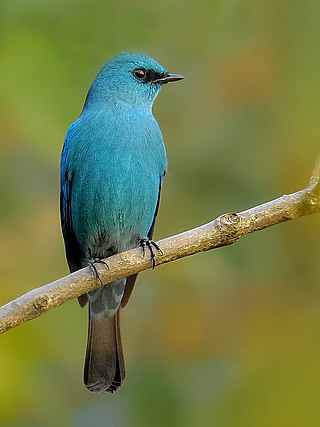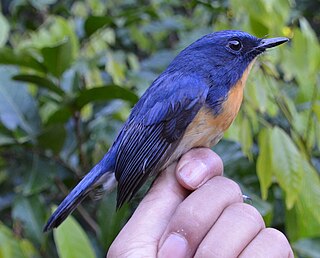
The New World warblers or wood-warblers are a group of small, often colorful, passerine birds that make up the family Parulidae and are restricted to the New World. The family contains 120 species. They are not closely related to Old World warblers or Australian warblers. Most are arboreal, but some, like the ovenbird and the two waterthrushes, are primarily terrestrial. Most members of this family are insectivores.

The Old World flycatchers are a large family, the Muscicapidae, of small passerine birds restricted to the Old World, with the exception of several vagrants and two species, bluethroat and northern wheatear, found also in North America. These are mainly small arboreal insectivores, many of which, as the name implies, take their prey on the wing. The family is relatively large and includes 357 species, which are divided into 54 genera.
The shortwings are colourful medium-sized mostly insectivorous birds in the genus Brachypteryx of the thrush family Turdidae, although some taxonomists place them in the Old World Flycatcher family Muscicapidae. They show strong sexual plumage dimorphism. All are southeast Asian species.

The white-bellied blue flycatcher is a small passerine bird in the flycatcher family Muscicapidae. It is endemic to the Western Ghats of southwest India. Males are dark blue with a lighter shade of blue on the brow and have a greyish white belly. Females have a rufous breast, a white face and olive grey above.

The Indian blue robin is a small bird found in the Indian Subcontinent. Formerly considered a thrush, it is now considered one of the Old World flycatchers in the family Muscicapidae. It was earlier also called the Indian blue chat. It is migratory, breeding in the forests along the Himalayas of Nepal, India, Myanmar and Bangladesh. They winter in the hill forests of the Western Ghats of India and in Sri Lanka.

The verditer flycatcher is an Old World flycatcher It is found from the Himalayas through Southeast Asia to Sumatra. This species is named after its distinctive shade of copper-sulphate blue and has a dark patch between the eyes and above the bill base. The adult males are intense blue on all areas of the body, except for the black eye-patch and grey vent. Adult females and sub-adults are lighter blue.

Brachypteryx is a genus of passerine birds in the family Muscicapidae containing ten species known as shortwings, that occurs in southeast Asia.

Rück's blue flycatcher is a passerine bird in the Old World flycatcher family Muscicapidae. It is known from only four specimens and is endemic to a small area in northeast Sumatra, Indonesia, inhabiting primary lowland forest. Although all specimens share common characteristics, such as a black bill, brown iris, and black feet, two of the collected specimens show some physical discrepancy with the other two. They were initially described as Cyornis vanheysti before being accepted as specimens of C. ruckii. Rück's blue flycatcher has also been compared to other species of Cyornis.

The Nilgiri laughingthrush is a species of laughingthrush endemic to the high elevation areas of the Nilgiris and adjoining hill ranges in Peninsular India. The mostly rufous underparts, olive brown upperparts, a prominent white eyebrow and a black throat make it unmistakable. It is easily detected by its loud series of nasal call notes and can be hard to spot when it is hidden away inside a patch of dense vegetation. The species has a confusing taxonomic history, leading to a range of names. In the past the species was considered to have two subspecies, the nominate form in the Nilgiris and jerdoni with a grey upper breast and found in the Brahmagiris of Coorg and Banasura range of Wayanad. They are omnivorous, feeding on a range of insects, berries and nectar.

The Nilgiri blue robin, also known as Nilgiri shortwing, white-bellied shortwing, Nilgiri sholakili or rufous-bellied shortwing is a species of passerine bird in the family Muscicapidae endemic to the Shola forests of the higher hills of southern India, mainly north of the Palghat Gap. This small bird is found on the forest floor and undergrowth of dense forest patches sheltered in the valleys of montane grassland, a restricted and threatened habitat.

The Flores jungle flycatcher is a passerine bird in the Old World flycatcher family Muscicapidae that is endemic to the Lesser Sunda Islands.

The white-bellied blue robin or white-bellied sholakili, is a bird of the family Muscicapidae. It is endemic to the Shola forests of the higher hills of southern India. The Nilgiri blue robin and this species were once considered separate species, later lumped as sub-species of a single species (major) and elevated again to full species in 2005 by Pamela C. Rasmussen. The species was earlier thought to be related to the shortwings and placed in the genus Brachypteryx and later moved to Myiomela since species in the genus Brachypteryx shows marked sexual dimorphism. In 2017, a study found that this is a sister group of the flycatchers in the genera Niltava, Cyornis and Eumyias among others. It was then placed in newly erected genus Sholicola. This small bird is found on the forest floor and undergrowth of dense forest patches sheltered in the valleys of montane grassland, a restricted and threatened habitat.

Trochalopteron is a genus of passerine birds in the laughingthrush family Leiothrichidae.

Myiomela is a genus of bird in the family Muscicapidae. Some members have sometimes been included in the genus Cinclidium and the phylogeny has not been resolved completely.

Apystomyiidae is a small family of flies containing the living genus Apystomyia and the extinct genera Apystomimus and Hilarimorphites. The single living Apystomyiidae species, Apystomyia elinguis, is native to California. Species of Hilarimorphites have been described from Mid to late Cretaceous Burmese and New Jersey ambers, while the single Apystomimus species is from the Late Jurassic of Kazakhstan.

The Banasura laughingthrush is a species of bird in the family Leiothrichidae. It is found in shola habitat in a small section of the Western Ghats in southwestern Karnataka and northern Kerala. It was formerly considered a subspecies of the black-chinned laughingthrush.

The Ashambu laughingthrush or Travancore laughingthrush is a species of bird in the family Leiothrichidae. It is found in the Western Ghats in southern Kerala and southern Tamil Nadu. It was formerly considered a subspecies of the grey-breasted laughingthrush. It is closely related to the Palani laughingthrush and can be differentiated from it by its very short white brow that stops before the eye.

The Meratus blue flycatcher is a species of bird in the Old World flycatcher family, Muscicapidae. The species was described in 2021 by the Indonesian ornithologist Mohammed Irham and his colleagues, based on genetic, morphological, and vocal differences with other Cyornis flycatchers. It is endemic to the Meratus Mountains of Indonesian Borneo, where it has been recorded only from Mount Besar. It is most common at elevations between 900 and 1,300 m and inhabits montane rainforest, secondary forest, and rubber plantations. It is sexually dimorphic like other species in its genus; males have blue upperparts, iridescent blue patches on the forehead and shoulders, and orange-and-white underparts, while females have gray-brown heads and upperparts. They have a length of 15.7–16.0 cm (6.2–6.3 in); males weigh 18.5–19.75 g (0.653–0.697 oz) and females weigh 15.75–20.0 g (0.556–0.705 oz).

















